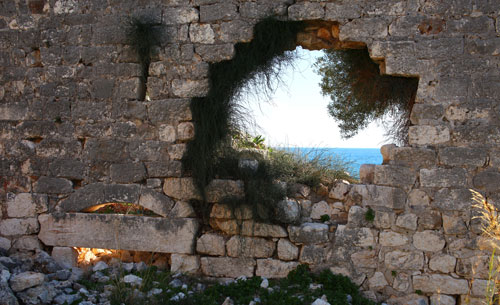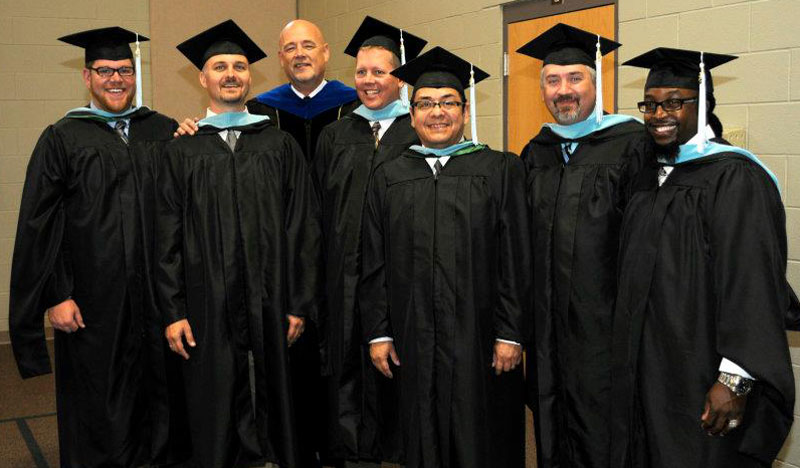June 19, 2012
|

This synagogue in Kizkalesi is believed to date back to the Roman period based on adjoining architecture.
 After discovering two previously unknown synagogues in Turkey, Huntington University Bible and Religion Professor Dr. Mark Fairchild (right) is sharing his findings in a noted academic journal.
After discovering two previously unknown synagogues in Turkey, Huntington University Bible and Religion Professor Dr. Mark Fairchild (right) is sharing his findings in a noted academic journal.
Fairchild will lead a UB tour of biblical sites in Turkey in October 2012.
In an article published this month in the Biblical Archaeology Review, Fairchild begs the question, “Could the world’s earliest known synagogue be buried amid rubble?” The Biblical Archaeology Review is a prestigious publication that documents archaeological digs relating to Biblical findings around the world.
In 2007 while researching in Turkey, Fairchild discovered two synagogues in the areas of Kizkalesi (the ancient city of Korykos) and Çatiören. In the years since, he has returned to conduct surface surveys and to continue his research.
“We know almost nothing about the churches that existed in Cilicia in that time period,” he said of that region of Turkey. What he and other researchers suspect is that the Apostle Paul established the churches during the 10 years after his conversion to Christianity. There is documented evidence, however, that Paul travelled through those regions on his missionary journeys later in life, Fairchild said.
“That’s why these synagogues are particularly interesting to me,” he said. “There is a good chance that Paul shared the Gospel message in these synagogue cities.”
The synagogue in Kizkalesi, Fairchild suspects, dates back to the Roman period based on adjoining architecture. The Çatiören synagogue, however, more than likely dates back to the Hellenistic Period around the 1st or 2nd Century B.C. If this proves to be true, it would be the earliest synagogue ever discovered.
In the BAR article titled, “Turkey’s Unexcavated Synagogues,” Fairchild calls for the excavation of these regions, particularly the synagogues, to unearth more of the treasures that they may be hiding.
“On my recent trip this summer, I found four more tombs with menorahs,” he said of the inscriptions in the stones. “I know there are more. That’s an indication of how many Jews lived in that area.”
As a researcher, Fairchild conducts surface surveys of the regions and then documents his findings. Over the past 15 years, he has visited more than 200 sites and plans to continue his work in Turkey in future years. Last summer, he visited 30 sites dating back to the 5th and 6th centuries B.C. This summer, he continued his research of ancient sites around Turkey from Gaziantep, near the Syrian border, to the ancient city of Iconium where Konya stands today.



 After discovering two previously unknown synagogues in Turkey, Huntington University Bible and Religion Professor Dr. Mark Fairchild (right) is sharing his findings in a noted academic journal.
After discovering two previously unknown synagogues in Turkey, Huntington University Bible and Religion Professor Dr. Mark Fairchild (right) is sharing his findings in a noted academic journal.
 “Occupational therapy is an in-demand field which is expected to continue to grow given recent medical developments with stroke survivors as well as people recovering from joint and hip replacements,” said Dr. Norris Friesen (right), senior vice president for academic affairs and dean of the faculty. “Given the interest in exercise science, our mission and the fact that there are no other similar programs in our area, this is a very unique opportunity for us to influence the next generate of occupational therapists with an accredited program that seeks to integrate God’s message of grace and love by helping people regain their strength and abilities to live full and fruitful lives.”
“Occupational therapy is an in-demand field which is expected to continue to grow given recent medical developments with stroke survivors as well as people recovering from joint and hip replacements,” said Dr. Norris Friesen (right), senior vice president for academic affairs and dean of the faculty. “Given the interest in exercise science, our mission and the fact that there are no other similar programs in our area, this is a very unique opportunity for us to influence the next generate of occupational therapists with an accredited program that seeks to integrate God’s message of grace and love by helping people regain their strength and abilities to live full and fruitful lives.”
 Today, the nursing pin is used to signify this same dedication: the end of formal education and the beginning of practice, a way of welcoming graduates into the nursing profession.
Today, the nursing pin is used to signify this same dedication: the end of formal education and the beginning of practice, a way of welcoming graduates into the nursing profession.













